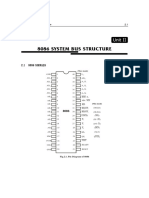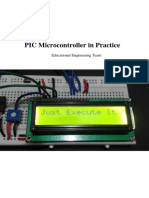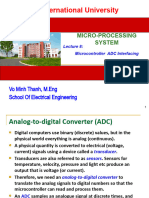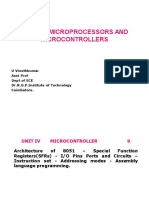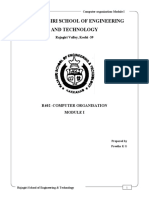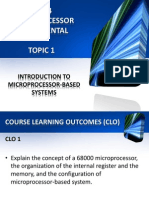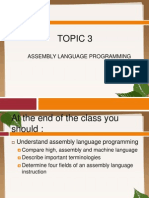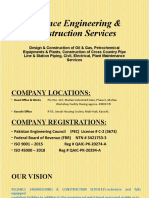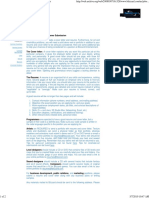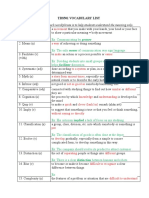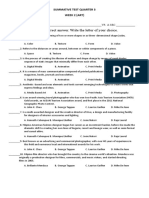Introduction to Microprocessor-based Systems
EC304: Microprocessor Fundamental
�What we are going to learn in this session:
What is a microprocessor. History of microprocessors. What is a microprocessor system. Components inside the microprocessor system:
Component description. Function. Arrangement.
Important terminology
�Microprocessors
�Microprocessor
A microprocessor is an electronic device that consists of millions (or billions) of transistors packed into one IC. Its function is to execute instructions in the form of programs, calculate and store its results. Microprocessor requires only one chip to build a complete system Microprocessors are used widely in our everyday lives.
�Everyday Items that use Microprocessors
�Microprocessor
P is a complex, powerful device:
Able
to process huge amounts of data. Built using transistors etched on silicon die. Needs external components to support operation.
Microcomputer system support P operations.
�Microprocessors Fabrication
1. Microprocessors are manufactured by etching transistors into an empty silicon wafer.
2. The etching process is done in a clean room using machines.
3. Once proper leads and connections are attached, the microprocessor is ready to be used.
�Microprocessor
The microprocessor can be used to perform complex operations by giving it instructions. These instructions are called programs. Programs are loaded into memory, and are executed line-by line by the microprocessor.
�History of Computers
�Microprocessor and Computers
Since its invention in 1970s, the microprocessor has undergone major improvements. We can look at the history of microprocessors by looking at computers and how they have evolved over the years.
�History of Computers
Has undergone significant improvements:
4
generations until now. Tied to development of electronics, semiconductors.
�History of Computers
G1 G2 G3 G4
Vacuum Tube
Transistor
IC
Better IC technology
�History of Computers
Whats next?
Conventional
computing:
Advancements in semiconductor technology. Smaller, faster, less power. More cores in one processor.
Unconventional
computing:
Quantum computer. Chemical computer. Molecular computer.
�History of Computers
First
Generation (1954-56):
Vacuum
Tubes as switches. Magnetic drums as memory. Very big, unreliable, slow. Examples:
ENIAC
(Electronic Numerical Integrator And Computer) (UNIVersal Automatic Computer)
UNIVAC
�First Generation Computers
Vacuum Tubes
Electronic Numerical Integrator and Computer (ENIAC)
�History of Computers
Second
After
Generation (1956-63):
invention of transistors. Smaller, faster, cheaper. Limited to military and business use.
�Second Generation Computers
Vacuum tube circuit
Transistor circuit
�History of Microprocessors
Third Generation (1964-71):
After
invention of Integrated Circuits (IC).
Many transistors can be packed into IC birth of microprocessors.
Early
microprocessors: Intel 8008, Intel 4004. Medium Scale Integration (MSI) and Large Scale Integration (LSI) devices.
�Early Intel Microprocessors
�Third Generation Computers
PC Laptop
�History of Computers
Fourth Generation (1971-now):
Improvements
in IC technology, P design. More transistors more processing power. Very Large Scale Integration (VLSI).
Intel Montecito Itanium: 1 bln. transistors.
Reduced
Instruction Set Computers (RISC). 32, 64-Bit microprocessors.
�Fourth Generation Computers
�Comparison between Computer Generations
Computer
UNIVAC (1st Gen.) IBM 1401 (2nd Gen.) DEC PDP-8 (3nd Gen.) Pentium III (4th Gen.)
Speed
1.3 kHz
Memory
1MB
Cost
$1.6 million
2.2 kHz
1.4kB
$47,900
1 MHz 500 MHz
6 kB 128 MB
$20,000 $700
�Microprocessor Systems
�Microprocessor Systems
Definition: A complete electronic system built around the microprocessor to support the microprocessor operation. May consist of CPU, memory, I/O (disk drives, keyboard, mouse), system bus, and supporting circuitry. CPU as the brain controls actions of all components.
�Microprocessor System - PC
ROM Floppy RAM
CD-ROM
CPU
Supporting Circuitry
Keyboard
Mouse
HDD
�Microprocessor System - Calculator
Memory
Power Supply
CPU
LCD Display
Keypad
�Block Diagram
Data Bus
CPU
(Microproc essor)
Address Bus Control Bus
MEMORY
I/O Interface I/O Devices
Unidirectional: Signals flow in one direction.
Primary: RAM ROM Secondary: Floppy CDROM Etc.
Bidirectional: Signals flow in both direction (one at a time).
�System Bus
A P-based system consists of many components:
CPU. Memory. I/O:
disk drives, keyboard, mouse. System Bus.
All components communicate using System Bus.
�System Bus
Communication highway for all components. A group of wires is called bus. Contains:
Data
bus: Address bus. Control bus:.
�System Bus Data Bus
Bidirectional (2 ways) bus. Transfer data to/from the CPU
Data bus Data bus
CPU
Control
signal is READ
R/W
Input (from Memory or I/O devices)
CPU
Control signal is WRITE
R/W
Output (to Memory or I/O devices)
Example:
Motorolla
68000 microprocessor has 8 bits data bus,
thus: Data size n = 8 bits, Data lines/bus are labelled Dn : D0, D1, .. D6, D7
The
size of data bus is determined by the number of lines (bits) which is also called data size.
�System Bus Address Bus
Single direction (unidirectional/1 way) bus Transfer the address data code to memory or devices.
ADDRESS BUS CPU CPU to other elements
Memory
I/O Devices
Example:
Motorolla 68000 has 16 bits of address bus:
n = 16 bits (Size of address bus)
Address bus is labelled An : A0, A1, .. A14, A15
216 = 65536 CPU can handle or address 65536 single cells (each cell has 8 bits data size) of memory.
In other words, 16 bit address lines can represent 65536 memory location 0 to 65535 locations, addressed as 0000h to FFFFh 16 address lines, then the size of the memory is equal to 216 = 64Kbyte.
��1 Kilo = 210 = 1024 1 Mega = 220 = 1024 K
1 Giga = 230 = 1024 M
2n = RAM size/size of memory
Example 1
8-bit
address bus
A0, A1,..A7
28 = 256 00h to FFh 28 = 256 byte
Address bus labeled Memory location
Address
Size of the memory
Example 2
32-bit
address bus
Address bus labeled
A0, A1,..A31
232 = 4,294,967,296 00000000h to FFFFFFFFh 232 = 22 . 230 = 4GB
Memory location
Address
Size of the memory
�System bus Control Bus
Control all the activities of the elements. Regulate information transfer, interrupts, error signals. Ensures that only one IC is active at a time to avoid a bus conflict caused by two ICs writing different data to the same bus.
�The CPU
CPU
Master of all components. Silicon chip that works as heart of the system Job:
Receive
instruction from memory to implement a task. Perform calculations (may use math coprocessor). Control bus operations.
�The CPU
CPU consists of:
ALU
(Arithmetic/Logic Unit):
Performs arithmetic/ logic computations.
CU
(Control and Timing Unit):
Responsible to retrieve instructions, analyze, then execute. Control unit
Registers:
Fast internal storage. Used to temporarily store addresses, data, processor status.
�Memory
Memory
Stores instructions/programs and data for CPU. Each memory location given unique address.
CPU
refers to address to access.
Types:
Read-Only
Memory (ROM). Random-Access Memory (RAM).
�RAM, ROM and NVM
ROM
Stores start-up instructions and critical system data and variables. Memory NVM
RAM
Stores general data and applications
�ROM
Read-Only Memory:
Data
can be read, but cannot be written (read-only). Contents stay without power (non-volatile). Usually contains basic start-up instructions, data. Stores data permanently without the presence of power supply but with very limited capacity. Contents hard-wired during manufacturing. Newer versions can be reprogrammed:
PROM: Fuse & anti-fuse. EPROM: UV light. EEPROM: Electrical current.
�ROM Examples
EEPROM Programmer EPROM Quartz Window
�RAM
Random Access Memory. Contents can be read and written. Loses data without electrical power (volatile). Advantages:
Programs
can be loaded and reloaded. Larger capacity.
Disadvantages:
Requires
power, refresh cycles.
�RAM vs. ROM
RAM is still empty because the computer has just been started.
Computer is turned on
CPU looks for instructions from memory
CPU loads instructions from ROM.
�RAM vs. ROM
ROM only has basic functions to start the computer.
RAM loads more advanced functions, such as the OS.
�RAM vs. ROM
RAM (Random Access Memory)
ROM (Read Only Memory)
Volatile Temporary storage where the information will lose when power off. Read&Write Flexible for being read or written via software Operation RAM is the main memory of the computer that holds the programs and information being processed. Usually is used to stored temporary data.
Non-Volatile Retain data even with absence of power. Read Can be read, but not write. ROMs are programed once (with assistance of hardware) Operation It is used by the computer to get started from power on (boot up). It includes BIOS (basic input/output system)
�Control and Timing Unit
All
Timing
Synchronizes all components in the system.
components refer to the clock timing for operations.
Generates square waves at constant intervals. Crystal oscillator + timing circuitry. Higher clock speed allow computers to function faster.
�Crystal Oscillator
Symbol
Equivalent Circuit
Sample
�I/O
Input/Output. Connects P with external devices:
Add
functionality to P.
Interfaces with P using ports. Examples:
Keyboard.
Mouse.
Display
monitor.
�How do ports connect to system bus?
Built into board Using card slots.
�Important Terminology
�Data Size
The capacity of a microprocessor is normally referred to how many bits of data can be handled at one time, or what is the memory size Data size is a mean of measure to determine how much data can be stored in a single cell of memory. Size of single cell in the memory. Data type :
Bit (B) Nibble Word (W) Longword (L)
�Example
A single cell sized 1 bit can store either logic-0 or logic-1. In other word, two different situations can be stored or represented. Thus the range of data is 0 1. Data size: n = 1 Data capacity : 2n = 21 = 2 Range : 0 1
A single cell sized 4 bit (Nibble) can store 16 possible situations. Data size: n = 4 Data capacity : 2n = 24 = 16 Range : 0 - 15
���Try This Question
A
single cell sized 1 bit can store either logic 0 or logic 1. In other words, two different situations can be stored or represented. Determine the following features of a single cell sized 32-bits.
�i) Data type = ? ii) Data size, n = ? iii) Data capacity = ? iv) Range = ?
�68000 Data Organization
�Byte View (.B)
�Word View (.W)
�Longword View
�Conclusion
�Conclusion
P is a complex, powerful device:
Able
to process huge amounts of data.
P-based systems provide supporting circuitry to support P functions. Long history, advancements along with technology. Executes instructions from memory in endless loop.
�Tutorial
�Tutorial
Name the 4 computer generations and the technological breakthroughs that caused them to happen. Draw the microprocessor system for a PC and explain the functions of each component in the system. List the three major parts of a CPU
�Tutorial
What are the three most basic components that are required in any microprocessor system? What is the function of the memory? List the two general types of memory. Explain the difference between RAM and ROM.
�Is the address bus unidirectional or bidirectional? Is the data bus unidirectional or bidirectional? What is the two main facts to determine the capacity of a microprocessor? What is the definition of data size?
The Motorolla 68000 has 16 bits of address bus: What is the address size? How to label the address bus? How many single cells of memory can be addressed? data bus; What is the data size and how to label the data bus?
The Motorolla 68000 microprocessor has 8 bits
�The End








